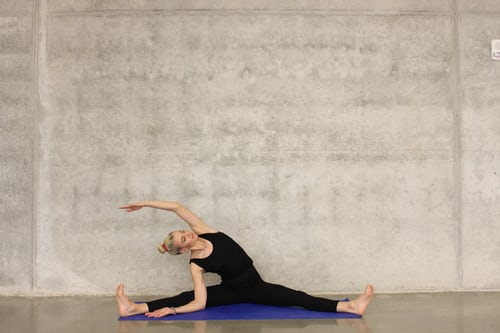I’ve been shirking my responsibilities in one big health and wellness area, an area a lot of people don’t pay enough attention to. But I should have known better. As a gymnast, it was a daily, if not hourly ritual or habit, and it helped keep me in top form for participating in my sport and avoiding injury.
It’s also something I droned on and on about to my injury-recovering athletes and patients.
What am I talking about?
Stretching.
My arrogant self just figured I’d always be naturally flexible, my limbs supple and pliable to extreme ranges of motion. Alas, it was not to be. Without me noticing, or taking heed, my muscles shortened into tight, mostly unresponsive bands.
I’m still recovering from a year of WAY too much sitting while writing. Marathon sitting episodes left me bent over, my legs numb and painful. It was painful for my feet, legs and back to just get up, straighten up, and walk around.
But I’m battling my way back, although I doubt I’ll ever achieve the flexibility I once enjoyed. And that’s probably a good thing, since I tended toward hyper-flexibility in some joints; and I suffer from the effects of being hyper-flexible in the joint where my lumbar spine connects to my sacrum (pelvis), an area known as the sacroiliac joint, or SI joint.
So now I’ve returned to my light morning and evening stretching regimens and added a couple of stretching periods to my workouts—one short one after I’ve warmed up on the treadmill for a quarter of a mile; and a long, intense stretch following the treadmill and elliptical workout (which usually totals 3 miles), before I head to the circuit stations or regular workout machines.
And it’s working! I’m able to move better, my reaction time has improved along with my sleep, and my workouts are stronger. It’s also helping me lose weight and re-shape my legs and arms.
What research says about stretching—
Harvard Healthbeat addresses stretching in its newsletter every so often and touts its benefits, particularly in older people.
Stretching helps you maintain your mobility, ability to twist and turn while doing basics activities like driving and moving comfortably around your home.
It also reduces your risks of falls and injury, injuries that can further hamper your flexibility because they sideline you result in muscle atrophy and strength loss.
Flexibility is important for maintaining muscle and tendon health. As we age, our muscles normally shrink, and the tendons lose their water content. But there is good news: you can reverse some of this process with mild, daily stretching periods of 5 or 10 minutes.
And when you’re more flexible and supple, you’re more self-confident in your daily movements and activities. Another physical and emotional plus side!
Getting down to stretching basics—
In a May 2019 health newsletter issue, Harvard discussed waning flexibility in the aging person and how it can be combatted.
“When you sit too much and don’t move around, the muscles in your hips, legs, and calves get tighter,” says Dr. Lauren Elson of the Physical Medicine and Rehabilitation Department at Harvard-affiliated Spaulding Rehabilitation Hospital, and faculty editor for Harvard Health Publishing’s special reports, Stretching and Starting to Exercise.
I can see this effect in my 97-year-old mother, a normally very active, strong and mobile woman.
For the last couple of years, she’s been spending more and more time sitting, trying to watch television through her severely macular-degenerated eyes, with her feet and legs elevated on a footstool (another health -no-no). Other aging residents of her former residence were the same. You could tell the way they maneuvered around with their walkers—stiff, shuffling, unsure.
Now that she’s in a memory care home, it’s worse. Not as much space to move around in, and not much to do. That means more sitting around in recliners and chairs with footstools. Regular physical therapy visits help a little, but it’s not enough.
This sad effect was obvious in the cadavers I had to examine and dissect in undergrad anatomy class. Younger people had full muscles; older people had barely- recognizable-as-muscles stringy ones.
Dr. Elson says you should approach stretching like any other health aspect you practice and perform on a daily basis—like teeth brushing. Yes! Teeth brushing. So add it to your daily prep time.
She also encourages you to aim for an entire-body stretching program that targets the major joints and muscles and takes those joints through their full range of motion.
The common problem areas are the hips, legs, low back, and shoulders and chest.
“These are the areas that you rely on most when performing routine movements, and the ones that suffer most when you’re sedentary,” says Dr. Elson. “Of course, everyone is different and you may have certain spots that are tighter than others.”
Dr. Elson is also a proponent of adding additional flexibility-minded activities, such as yoga and tai chi. They have great programs geared toward the older adult, so you might want to start with those. DVDs can get you started at home, in the comfort of your own living room.
Be careful with the yoga, though. Some poses and stretches are not indicated for people with arthritis.
Getting started with your stretching now—
If you’d like to read the article, here’s your link. It gives you four daily stretches you can start right now!
Next week, we’ll delve into Part 2 of stretching. I’ll give you my opinion on static stretching versus bouncing. That’s been a topic of contention and controversy for years.
I’ll also give you some additional resources to use in your quest for flexibility
Until then, happy stretching
Blessings,
Andrea
Andrea Arthur Owan is an award-winning inspirational writer, fitness pro and chaplain. She writes and works to help people live their best lives—physically, emotionally, and spiritually.
